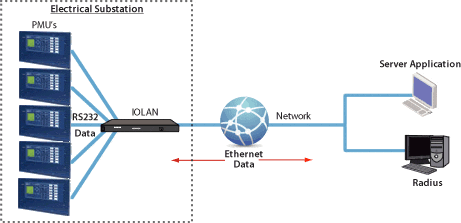US Department of Energy uses Perle Terminal Servers to meet NERC CIP Compliance
Perle IOLAN Terminal Servers provide secure remote user authentication and management capabilities to keep smartgrid stable and reliable.
The Utilities Industry is not exempt from being hauled into the 21st century and subjected to "smart" technology. Similar to a smart phone — a more advanced phone with more computing capability and connectivity — utilities are working on the smart grid. The smart grid generally refers to a class of technology used to bring utility electricity delivery systems up to date, using computer-based remote control and automation. The grid is the network that carries electricity from the plants where it is generated to the users and includes substations, transformers, switches and many other devices. For decades, utility companies sent workers out to gather much of the data needed to provide electricity. They read meters, locate and replace damaged or broken equipment and measure voltage. Adding the smart to the grid essentially involves computerising the grid — adding 2-way digital communication technology to devices associated with the grid. Some obvious benefits are massive cost savings associated with expensive visits to remote substation locations, as well as enhanced cyber-security.

When the United States Congress made $52.9 million available to the Department of Energy (DOE) for funding smart grid technology, the Western Interconnection Synchrophasor Project (WISP) was born. Synchrophasor measurement is a smart grid technology that keeps a grid stable and reliable. The technology protects equipment by establishing a virtual firewall between generation and transmission. Key measurements include positive sequence voltage, real and reactive voltages, current, and frequency rate of change which have been attributed to addressing problems that surface during major blackouts.
More than 160 Schweitzer SEL-487E Station Phasor Measurement Units (PMU) were installed throughout the northwest United States to achieve better situational awareness, wide area control and protection, model validation, system performance and event analysis. Simply put, when the equipment is protected the grid is stable, and that prevents blackouts.
The SEL-487E PMU provides data communication over a serial RS232 port. Agencies within the DOE needed a solution that would allow personnel to remotely manage the PMUs using a RADIUS server — as required under the NERC CIP directive 005 R3.2.
The North American Electric Reliability Corporation (NERC) is responsible for working with all stakeholders to develop standards for power system operation, monitoring and enforcing compliance with those standards, assessing resource adequacy, and providing educational and training resources as part of an accreditation program to ensure power system operators remain qualified and proficient. Updated by President George W. Bush early in his first term, the standard known as Critical Infrastructure Protection (CIP) is a directive that relates to the preparedness and response to serious incidents that involve the critical infrastructure of a region or the nation. NERC CIP broadened the definition of infrastructure, in accordance with the Patriot Act, as the physical and virtual systems that are so vital to the United States that the incapacity or destruction of such systems and assets would have a debilitating impact on security, national economic security, national public health or safety.1
For personnel to remotely manage the PMUs, Perle IOLAN Terminal Servers were selected.
The DOE wanted to leverage the Perle IOLAN Terminal Server to provide a method for users to authenticate via RADIUS. The IOLAN would provide the access level username and password to the PMU, allowing the field users to perform their duties, while obscuring the password.
By working closely with the DOE, Perle was able to ensure the IOLAN Terminal Server provided the different levels of password authentication to the PMUs, and the DOE was able to meet its NERC CIP compliance obligations without restructuring its existing network or purchasing additional hardware.
About the U.S. Department of Energy
The mission of the DOE is to ensure America’s security and prosperity by addressing its energy, environmental and nuclear challenges through transformative science and technology solutions.

